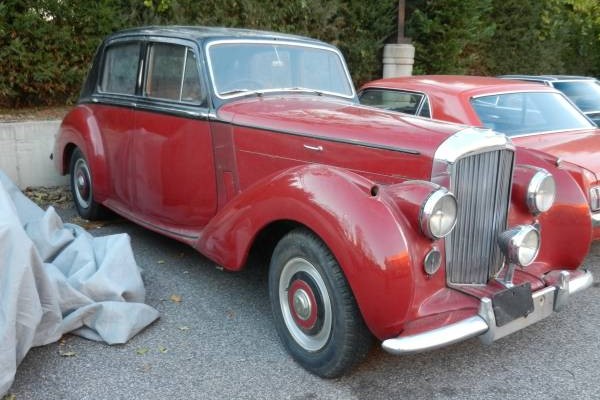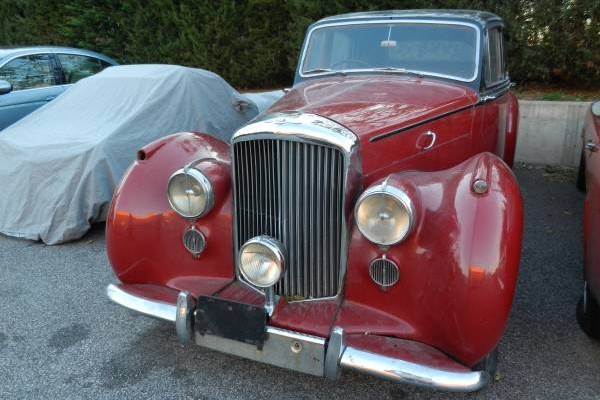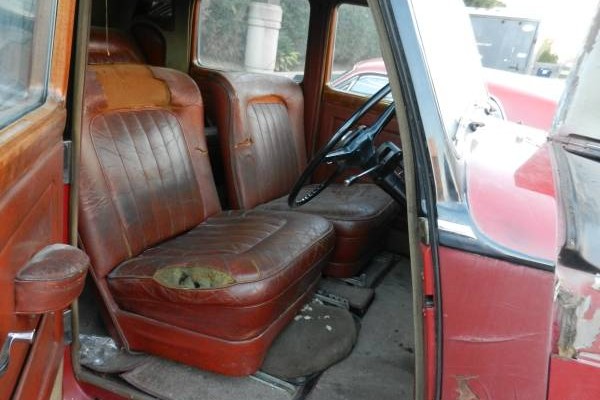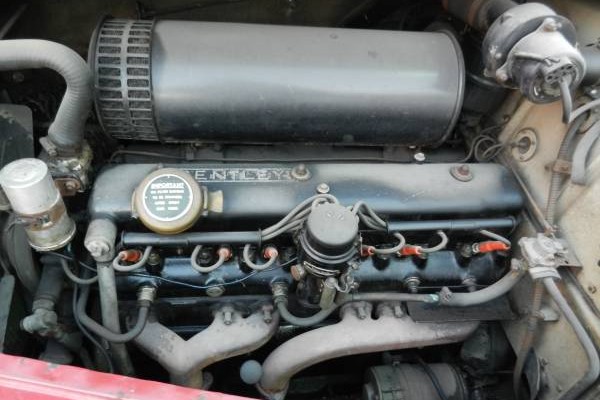Only 2,323 Bentley R-Type saloons were made in Crewe, Great Britain from 1952 to 1954. It’s safe to say that not very many of them have the sunroof option, and fewer still have made their way to America. So this example for sale here on craigslist in Syosset (Long Island), New York, is quite unusual.
We don’t have a clue from the ad how long it’s been in storage – owner says “many years.” We do know that the engine does not run, but the car is complete, and the pictures provided do support that claim.
This is a very beautiful car. Bentleys of this era are for the most part, hand-built cars, representing the best of British car manufacturing of the post-war era. The leather here is worn and in need of repair, but the body looks remarkably sound and the engine does seem to be all there. The body might have had some rust repair, and without seeing the undercarriage, it’s impossible to know what kind of work might be required to make this car driveable again.
But as with most long term stored barn finds, you have to presume it will need plenty of work. It’s not uncommon for cars like this to have been put away when owners chose not to perform needed repairs because of high costs. Parts and labor to work on Bentleys and do the work correctly will add up (except for the automatic tranny, which is a good old GM hydramatic and therefore relatively easy to repair).
And this car is probably worth the effort. Even with the seemingly high asking price of $19,500 (or best offer), with the values these cars have reached now, for the right buyer, this might be a bargain.
Although the fact that it is a right hand drive model knocks 30% off the book value, in #2 excellent condition Hagerty lists this car at almost $100,000.
It’s impossible not to admire the beauty of this Bentley, and to imagine the pleasure of “motoring” around the country side, cosseted by hand made leather seats and surrounded by shiny burled wood throughout. Nice find!









Maybe they can send it back to England. I doubt there is even much of a demand for these for weddings anymore.
Not sure how you got those values, but that is a plain jane steel bodied R-Type. In excellent shape it’s worth about $40K. In that condition, maybe 10 on a good day. The right hand drive -30% is more of a 30% boost if it has the far less common LHD. They are trouble prone like any British car of that era. You’ll need a set of Whitworth wrenches, and get this – the brakes are mechanical in the rear, and hydraulic in front. If it explains the mindset of the engineers at Bentley any, the front wheel cylinder bleeder screws are a Whitworth thread pitch, but not even a standard Whitworth thread count…
You’ve never actually owned one have you?? Otherwise you’d sing a different tune.
You can “know” something without having “owned” it. He seems to have intimate knowledge of some of the intricacies.
Brakeservo, You sound like someone who has owned 232 of these cars, but never had to work on one. (this is all to be read in a friendly, light-hearted tone)
No, I don’t own one, but I am tasked with maintaining a pair my father owns, a ’51 James Young Coupe, and a ’53 Saloon,’ like the one in question. I love British cars and British humor, and sometimes I find that they coincide.
These cars are well built, to a fault. I don’t know if the folks who did the engineering work had a chip on their shoulders about the once great British empire, or just refused to look outside themselves, but there are some things so anachronistic about the R-Type that you can’ help but laugh. My only intention was to mention a few of their oddities. You have to admit, in the post WWII era, there was so much new technology, and yet, these cars seem to refuse to acknowledge it.
I guess you don’t know the area where this Bentley is located? It’s not unusual to see these kind of cars on the “Gold Coast” of Long Island. There used to be a bunch of old Mansions in the area. Most were sold & redeveloped into 2 acre plots at minimum sized plots. I did a lot of work up there over the years. There’s also a bunch of car collectors around there. A lot of well named people also live around there.
There you have it! ;>)
Too bad it’s not an R-Type Continental coupe. Those are now $1-$2 million cars. I don’t know about the coachwork on this car, and neither does the seller, but that makes a big difference with these. The SCM Guide says these can vary from $49K to $175K depending on the coachwork. That’s for a #2 condition car, which this one isn’t. Thayer says it’s what SCM calls a “standard steel saloon”—the lowest valued model—so the $40K and $49K valuations are at least in the same ballpark, with the SCM value high because of its high end auction orientation.
I can’t see it selling for much unless you can get it running and driving and then find the exact right buyer—maybe in the UK….maybe for spares. I’m guessing there’s just not much market.
To correct a few misperceptions, if you ever find one of these built WITHOUT a sunroof, you’ve found a rare example indeed. Of the 232 I’ve owned over the past 30 years I’ve never seen one! Also, there are now more of these cars in America than England or anywhere else. They may be old and British but they are so well built many still run well despite decades of neglect. When the brakes are set up right (and it’s easy if you know what you’re doing) you will find them to be the finest drum brakes you’ve ever experienced. 80-+ mph cruising speed with swift acceleration and precise steering combine to produce the best undiscovered classic in the world today. Extremely robust, reliable and easy to service, many common wear parts are available at any corner auto parts store. I’ve sold exceptional ones for $80,000-+ and good ones for $50,000+.
You must travel in the same circles as Bhagwan Rajneesh! Were yours LHD or RHD? What was it you did not like most about the cars? Best?
Holy crap the dust on that reference is an inch thick randy.
I am glad someone got the reference. I was working in Addison, Tx. When it all took place. What a fine collection of cars he had.
Funny you should mention the Bhagwan Shree Rajneesh – I moved to Oregon 31 years ago (driving Watergate criminal John Eichmann’s old 1959 Mercedes 220S ‘ponton’) when the guru was at the height of his reign and while I never personally had any interaction with him or his followers, I certainly knew quite a few people, ranging from the local Rolls-Royce dealer to politicians and law enforcement officers who did have to deal with that group of Bozos. By the way, his followers only bought him brand new cars and it’s my contention that the last Rolls-Royce or Bentley worth owning was built in 1959 but to answer your inquiry – nearly all mine were RHD, indeed the only Rolls-Royces or Bentleys that I’ve ever lost money on were the LHD cars when I found that in reality people are unwilling to pay anymore for LHD than they will pay for RHD.
As to what I like best about these cars . . . although the engineering was anything but state of art, indeed the cars were technically obsolete even when brand new, every-time I get behind the wheel of the 1953 Bentley I own today I’m reminded of just how ‘right’ and ‘perfect’ these cars feel to a driver. The weight of the steering through that huge wheel, the placement and precision of the manual gear shift, just the satisfying tactile feel of everything about operating the car let’s you know you are driving a machine built to the highest standards. Not just quality – but the overall ‘integrity’ of the machine, you can feel that nothing was done to a price or compromise. For instance the throttle linkage is all mechanical rods and joints, no cables or ‘good enough’ solutions. If I had to sum it up in just one word, I’d say ‘magnificence.’ What I don’t like about the cars is the overall complexity which can make some things extremely labor intensive. For instance, there were a few hundred made where someone with normal human sized hands and fingers will have to remove the intake manifold to change the oil filter! But you can also convert them to modern ‘spin-on’ oil filters today, a change I think makes sense.
I contend that as functioning automobiles, these are far superior to say a Ferrari 250GTE or an old 330GT (of which I’ve also owned several examples) because they are every bit as satisfying to drive and so much more reliable and cheaper to repair and maintain.
I know of no other very limited production truly great 60 – 63 year old car that is 1) still so affordable today, 2) capable of comfortably and safely traveling faster than contemporary traffic laws allow, 3) is so intrinsically so good looking and well built. These today absolutely run rings around any other automobile produced in 1953. There is no sane reason they should be so cheap. Again to compare with the million dollar plus 2 door fastback Continental R version – they give you 95% of the experience at only 5% of the price!
The Bhagwan was a big deal in N. Tx, and it left an impression on me. Thank you for taking the time to discuss these cars, it is quite obvious that these are by far your favorite. If I ever get to another big car show, I’ll have to do a thorough inspection on one of these.
Yup. These ALL had the sunroof.
Lovely cars. Drive like an old truck, but lovely.
I thought the GM transmission didn’t show up until the Silver Clouds/S-1s. Do you know for sure?
Rolls-Royce put the first automatic into a Bentley R Type in late 1953. The first few hundred or so they bought from GM but then built their own and found that the transmissions they built simply didn’t work as well as the GM transmissions because Rolls incorporated such a higher degree of precision yet they functioned better when built with the sloppier GM tolerances! There were about a dozen or so early Bentley S1’s built with the old four-speed manual box, but every Cloud and succeeding models were automatic only.
My father owned one of these exact cars in the 1970’s. It was a beautiful car. Wish I had it now. BTW, it did have a sunroof.
There was a similar car at a shop next to mine years ago. It sat neglected for a decade or so. I tried to warm up to it and could have bought it for 1500.00 but when we got it running, I didn’t think it was as good a car as my similar age 220S and it was small. Interior was like a VW bug, narrow and sat sort of upright. I always felt my Mercedes handled much better, had more power, the interior was more comfortable (but not as pretty). So with the cost of wood and leather restoration……..I stayed Teutonic.
Before I started collecting Bentley and Rolls-Royces I too had number of 1950’s era ‘ponton’ Mercedes ranging from the 180 through the 220S. Any rational person will agree the engineering of the Mercedes was far more advanced than the Rolls product yet the Rolls was so well built it was an altogether more comfortable and reliable car. No doubt such a Mercedes will run away from a Bentley on a twisting canyon road but I believe you are mistaken about the size of the interior. While the vertical windshield on the Bentley / Rolls was right in front of the driver’s face just like a VW, in reality there is far more room for the driver and passenger than in the Mercedes but I can see how the perception of a small interior space could arise. You are right that the Mercedes will out-corner and out-handle the Bentley but down a straight line or in a drag race the Bentley will blow the Mercedes away. With modern radial tires the Bentley is not a bad handling car at all – I have done track days with mine and always amazed bystanders!
I do think they are a fun car…….I nearly bought an old Frank Loyd Wright car from my buddy Tony Handler in the 90’s. It was a white one with a drivers compartment that could be opened…….I can’t remember the term for it…..but even Tony, who made a good living on old Crew built cars, said they were not really a good car. He preferred driving a Mercedes. He would always point out the huge amount of body lead used to fair the sheet metal. There was usually 1/2 an inch where the windshield frame attached to the firewall. He said at the factory, they would true the body with long pry bars and fill in the gaps with lead. If a car had been driven hard, the lead would start to pop out with flexing of the body. Again, I think they are fun cars. It looks like they have become expensive. I am sure even though realitivley few were built, the survival rate is high because they have always been interesting. Do you remember the movie, the Yellow Rolls Royce? (Was that the name) fun stuff.
Greetings All,
Brakeservo, right you are, on both Mercedes and Bentley’s design disciplines.
Jaguar, Bentley, maybe some of the lesser tier vehicles noticed something.
While working in the UK back in the 80’s, was looking for a MKVII, VII, or IX to export home to the US.
Never found a big one over there but did find a MKII. Since I was in the Place of origin, took inventory of what the car needed and hit a parts store. Wanted some of the famous Lucas switchgear. Was introduced to Lucas’s rebuild kits which everyone stocked as switches were special order. Labor on installing rebuild kit was more than replacing switch outright.
My Ponton Mercedes, on the other hand still has the same Bosch switchgear it had when I purchased it in ’78. Bosch’s reliability was cemented in my mind right up until my Jetta of 5 years ago. That’s when I found out Bosch now makes several grades of switchgear, of which my Jetta was the lucky recipient of the lowest quality and likely price, that Bosch sold.
There is something oddly unique about Bentley designing a shift mechanism so the American market could still shift with their right hand, as if that would be the reason they didn’t sell enough cars to the US. Somehow I managed to shift lefty with my MKII and that is a Moss box with reverse and first in the same shift plane.
With regards to engineering disciplines, the Bentley and many other English cars seem to favor convention over innovation as the feeling is the conventional has less to go wrong, no matter how antiquated the mechanism may look.
The Germans practice simplistic sturdiness, with great materials. Sat stupidly looking at my rear view mirror in my Fintail 300SE for about twenty minutes. Trying to ascertain how to remove the thing without damaging the wool headlining. Finally an epiphany! Grabbed the unit firmly and pulled. Unit came out, it was heavily spring loaded. To be that heavily sprung, the surround that held it was a work of art, well made, simple and securely fastened with two screws.
There wasn’t a Ponton made with anything larger than a 220/2.2 liter fuel injected engine. The Bentley has significant more displacement, though guessing the weights are similar.
Automatics and the Brits……….. The story I read was similar but much early. Rolls Royce contracted with Chrysler back in the late thirties for their revolutionary new automatic, as Rolls didn’t want to miss the opportunity to offer their cars with an auto. Rolls also was not going to spend the money to develop their own for such small production numbers.
Rolls purchased a batch of these to be used for future production. Engineering expressed an interest and one was torn down to examine and was later to be reassembled, after all nothing they couldn’t handle.
Disassembly with Rolls technicians found many derogatory comments being made about the finish quality of the internals that came from the Colonies. It was decides that the parts were to be finished to a quality that befitted RollsRoyce. The entire batch of transmissions were disassembled and various parts were polished and finished to a respectable level that they felt represented Rolls Royce.
The transmissions, once installed, exhibited the symptoms you describe, just not due to the high tolerances of their engine work as automatics don’t work that way. Bottom line, they didn’t function.
The only reason any of this is known is that the correspondence to and from Rolls and Chrysler and the attempt to get this resolved is hilarious. The English take no responsibility as their actions could have only improved the process. Chrysler politely disagreed.
Jaguar and Bentley went through the same type of issue. Bentley had purchased an early 40’s or 50’s new jaguar sedan to understand how Jaguar could manufacture a car at that price, and no doubt to steal, I mean assimilate some of those techniques into Bentley’s own production.
Bentley then did a series of grueling destructive tests and wanted Jaguar to reimburse them when the parts failed, like the…….engine, leaf springs, etc. The letters are comical as each party knows why the car was purchased and the tests carried out, being done in a common area, with each party not acknowledging what happened yet William Lyons isn’t willing to give them an engine but will make one available for a trade discount.
It was a different time obviously, judging by each parties politeness.
That straight 6 is beautiful.
Sorry. After all these years, I still can’t look at one of these without thinking of Grey Poupon.
re: Dave Wright – Yes, I’ve known Tony for over 30 years also. The term you’re looking for regarding a car with an opening driver’s compartment is Sedanca and all were individually coachbuilt. Indeed the shortcomings in construction you refer to really apply only to the coachbuilt cars as they were individually erected one at a time by craftsmen and not by Bentley or Rolls-Royce. Those who decried the standard steel body that came out in late 1946 on the Bentley Mark VI and in 1949 on the Rolls-Royce Silver Dawn fail to recognize how much better built and durable (once the metallurgy improved) the standard body is. Indeed, today if you crash one you can still get new sheet metal pieces to fix it! Crash a coachbuilt car and you’ll have to hire a carpenter and panel beater to put it back together again! Granted, the problem with neglected cars is RUST! But it’s usually easier to fix than rotted wood framing and bent, corroded aluminium.
BrakeServo is correct in what he says about these cars. I owned a very reliable 1954 “R” [B216YD chassis #] — Note that most Bentley owners know the serial numbers of their older cars ’cause they are so short.. It was an automatic ‘box, and with the larger engine & twin carbs, it was quite fast. Also very reliable. As to the brakes — I wish all my vintage cars with drum brakes [even the ones in the 1960s] would stop as well as the Bentley & Rolls-Royce cars I’ve owned. And as to the sunroof question — every standard steel saloon Mark IV and “E” type came standard with a sunroof. One had to specifically request that a car NOT be built with a sunroof, if that was what you wanted.
I’ve owned 3 Mark IV cars, as well as a ’52 Silver Dawn Rolls-Royce, along with the above mentioned “R”. I regret selling both the Dawn & “R”. When maintained, they are very reliable and fun to take on long trips.
And having owned a Ferrari 250GTB 2+2, that car required constant maintenance and repairs. Bought it for $1,200 USD in Germany back in 1975, sold it 6 months later for $1,800 and was glad to do so!
A few years ago I installed a modern electric power steering in a R type. While I was used to 60s british classics, I had no real experience with the older generation. The Bentley greatly surprised me when taking a test drive. Fast, very good brakes, soft springs but not too soft, a great car to drive. I did not expect that, a pleasant surprise!
I have since put a MkVI (or R type) on my “must have” list for the future.
Hi.
All of these comments are very interesting. This R-Type is in a sorry state and deserves to be returned to its original beauty. It was originally black over shell grey . The engine is original to the chassis. It is complete apart from the spare and one side light. It’s original UK registration number is UVK 222.
You may have guessed that I’ve bought the car and am in the process of returning it to the UK where it will be lovingly restored.
I would appreciate any information that anyone has regarding its time in the USA.
A beautiful and significant car but alas, under-appreciated here. A return to the UK is probably a good move for this one.